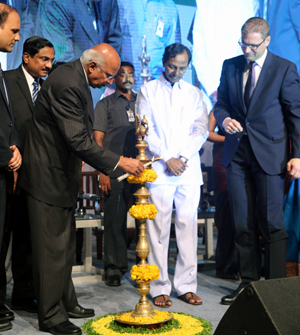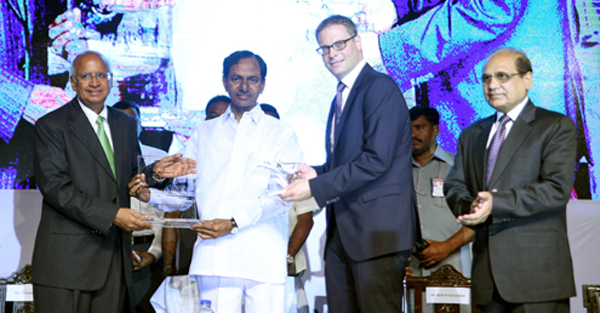|
 The
ground breaking ceremony was held here June 23
in the presence of Telangana Chief Minister K
Chandrasekhar Rao, and sources told India
Strategic that RUAG had placed an
initial order for 12 structural units approximately
valued at Euro 15 million. The agreement though
is for 50 units over the coming years. The
ground breaking ceremony was held here June 23
in the presence of Telangana Chief Minister K
Chandrasekhar Rao, and sources told India
Strategic that RUAG had placed an
initial order for 12 structural units approximately
valued at Euro 15 million. The agreement though
is for 50 units over the coming years.
The Dornier New Generation (NG) is stated to be cheaper to buy and cheaper to operationally operate than the
old Dornier 228 that India bought in 1984. It has smaller but more efficient composite material propellers and
its new engine will need maintenance after 7,000 flying hours as compared to less than 4,000 hours made by HAL in
India. The Tata group is interested to progressively manufacture the entire aircraft depending upon the orders
and technology induction.
RUAG is interested in sharing the technology, and this has been conveyed to the Chief Minister of this recently
created new state. RUAG will take the structural units to Germany, and build them in various configurations as required,
from transport to surveillance aircraft.
The Chief Minister observed that his “goal is to make the Made in Telangana label as a globally recognised brand for
its quality and innovativeness," adding that the city hosts many state-run research and development bodies also like
the Defence Research & Development Organisation (DRDO), its affiliates, DRDL, Midhani and BDL.
Describing the Tata-RUAG partnership as a glowing example of Indo-European cooperation, TASL Chairman S Ramadorai
said: "Our vision is to work with Ruag in having a full aircraft, equipped with systems flying out from a Tata final
assembly. This will be of significant importance to the Indian Armed forces in their desire to produce products locally.”
At present, HAL supplies the Dornier 228-201/101 model to the Indian Air Force (IAF), Navy and Coast Guard. This had
first come to Indian end-1984, and had been used also by Vayudoot, the regional subsidiary of the Indian Airlines for
civil operations.
Ramadorai also added: "It is our belief that this project is
a significant step forward in India's growth as
a high technology, precision, manufacturing destination.
RUAG has entrusted the Tatas to deliver its showcase
product, the Dornier 228, at world-class standards
of precision and quality."

TASL and another Tata group company, Tata Motors, are making aircraft body and parts for Boeing 787 Dreamliners (Floor
Beams), Sikorsky S 92 helicopters (Fuselage) and Lockheed Martin C 130J Super Hercules (Empennage and Centre Wing Box).
TASL, which has a world class facility here with high quality standards and a disciplined, efficient workforce, has in
fact delivered 70 fuselage units – or cabins – for Sikorsky S 92, and most of them are flying in various parts of the world.
Notably, a variant of this helicopter has been selected by the US Marine Corps for US President’s use in VVIP configuration,
and the basic body structure for that is also likely to be supplied from here by the Tatas.
The entire production of TASL units is exported at the moment.
Mr Ramadorai said Hyderabad (in central India) had become a premier destination for global aerospace companies. US Honeywell,
which has some 10,000 employees in India, is another global major to have a high tech facility here.
Mr Martin Bühlmann, vice-president of supply chain management at RUAG, observed: "We found a strong partner in Tata for
the backbone of the plane-fuselage and wing.” The fuselage and wings made by TASL will be taken to RUAG at its Oberpfaffenhofen
facility near Munich, Germany for final assembly.
He said that RUAG, an Airbus company, had launched the Dornier 228 NG in 2010 after upgrading its twin engines, cockpit and
onboard electronic systems, and fitting it with a five-blade propeller made of composite material.
Around 270 Do-228s were built and 127 of them are reportedly in service worldwide.
|